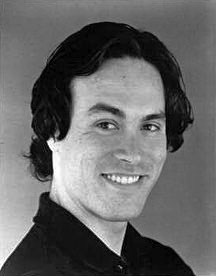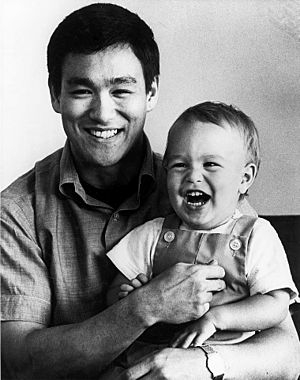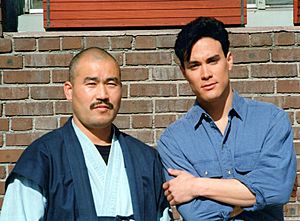Brandon Lee facts for kids
Quick facts for kids
Brandon Lee
|
|||||||||||
|---|---|---|---|---|---|---|---|---|---|---|---|
| 李國豪 | |||||||||||

Lee in 1992
|
|||||||||||
| Born |
Brandon Bruce Lee
February 1, 1965 Oakland, California, U.S.
|
||||||||||
| Died | March 31, 1993 (aged 28) |
||||||||||
| Burial place | Lake View Cemetery, Seattle, Washington, U.S. | ||||||||||
| Occupation | Actor, martial artist, fight choreographer | ||||||||||
| Years active | 1985–1993 | ||||||||||
| Partner(s) | Eliza Hutton (1990–1993; his death) |
||||||||||
| Parents |
|
||||||||||
| Relatives |
|
||||||||||
| Chinese name | |||||||||||
| Traditional Chinese | 李國豪 | ||||||||||
| Simplified Chinese | 李国豪 | ||||||||||
|
|||||||||||
| Signature | |||||||||||
 |
|||||||||||
Brandon Bruce Lee (born February 1, 1965 – died March 31, 1993) was an American actor and martial artist. He was becoming a popular action movie star in the early 1990s. His most famous role was Eric Draven in the movie The Crow (1994).
Sadly, Brandon Lee's life and career ended too soon. He died in an accident while filming The Crow.
Brandon was the son of the famous martial artist and movie star Bruce Lee. His father passed away when Brandon was only eight years old. Brandon followed in his father's footsteps. He trained in martial arts and studied acting at Emerson College and the Lee Strasberg Theatre and Film Institute.
He started his acting career with main roles in the Hong Kong action film Legacy of Rage (1986) and the movie Laser Mission (1989). Brandon also appeared in two TV shows related to the 1970s series Kung Fu. These were the TV movie Kung Fu: The Movie (1986) and the pilot episode Kung Fu: The Next Generation (1987).
Later, Brandon moved on to Hollywood movies. He starred in the Warner Bros buddy cop film Showdown in Little Tokyo (1991) with Dolph Lundgren. This movie later became a cult film, meaning it gained a loyal fanbase over time. After this, he had a main role in Rapid Fire (1992). Even though the movie wasn't very popular, people praised Brandon's acting.
Brandon was chosen to star in The Crow. He had filmed almost all his scenes when he was accidentally hurt on set by a prop gun. He passed away from this injury. After his death, his performance in The Crow was highly praised. The movie became a big success with both critics and audiences. Many people have noticed how similar his career was to his father's. Both men died young, just before their most important films were released.
Contents
Early Life and Training
Brandon Lee was born on February 1, 1965, in Oakland, California. His parents were the famous martial artist and actor Bruce Lee and Linda Lee Cadwell. From a young age, Brandon learned martial arts from his father. His father was a well-known expert and a martial arts movie star.
Brandon's family lived between Hong Kong and the United States because of his father's work. Brandon became interested in acting while visiting his father's movie sets. Sadly, his father died suddenly in 1973, when Brandon was only eight years old.
After his father's death, Brandon's family moved back to California. When he was nine, Brandon started training with Dan Inosanto, one of his father's students. Later, he also trained with Richard Bustillo and Jeff Imada. Imada said that as a teenager, Brandon found it challenging to train in places with many pictures of his famous father. This led Brandon to try soccer instead of martial arts for a while.
Brandon was a bit of a rebellious high school student. In 1983, he left Chadwick School before graduating. He then earned his high school diploma from Miraleste High School.
Brandon later moved to New York City to study acting. He took lessons at the Lee Strasberg Theatre and Film Institute. He then went to Emerson College in Boston, Massachusetts, where he studied theater. During this time, Brandon acted in several plays.
Becoming a Star
Early Acting Roles (1985-1990)
In 1985, Brandon Lee returned to Los Angeles. He worked as a script reader, which means he read movie scripts to give his opinion. During this time, he got his first acting role in Kung Fu: The Movie. This was a TV movie that continued the 1970s TV series Kung Fu. David Carradine returned as the main character.
Brandon reconnected with his former instructor, Jeff Imada, on set. Imada worked in the stunt department. Brandon was not very keen on martial arts films at first, as he wanted to avoid being compared to his father. However, he took the role. The movie aired on February 1, 1986. Brandon felt it was fitting that his first big role was in a project related to a show that was originally thought of for his father.
That same year, Brandon starred in his first main film role, the Hong Kong action crime thriller Legacy of Rage. In this movie, Brandon plays a young man wrongly blamed for a crime. It was the only film Brandon made in Hong Kong and in the Cantonese language. He was nominated for a Hong Kong Film Award for Best New Performer for this role. The film was successful at the 1987 Cannes Film Festival and in Japan.
In 1987, Brandon starred in another Kung Fu spin-off, a TV pilot called Kung Fu: The Next Generation. It aired on a show that featured rejected pilots. The story was about the grandson and great-grandson (Brandon) of the original series' main character. The pilot was not well-received and didn't become a full series.
In 1988, Brandon had a role in an episode of the TV series Ohara. He played the main villain, the son of a yakuza (Japanese gangster). Jeff Imada, who was the stunt coordinator, said Brandon was advised not to take the role. But Brandon saw it as a chance to show his acting skills and took it.
In 1990, the movie Laser Mission was released. Brandon played a mercenary on a mission. It was a commercial success when released on home video. Critics generally didn't like the film, but some found it to be an entertaining action movie.
In the 1980s, Brandon started training again with Dan Inosanto. He would bring a camera to his training sessions to see which martial arts moves looked best on screen. Around this time, Margaret Loesch, a CEO at Marvel Comics, met with Brandon and his mother. Comic book writer Stan Lee (no relation to Brandon) thought Brandon would be perfect to play the superhero Shang-Chi in a movie or TV show.
Hollywood Success (1991-1993)
In April 1991, Brandon Lee was considered to play his father in the movie Dragon: The Bruce Lee Story (1993). But he turned down the role. He felt it would be too strange and awkward to play his own father. Also, the producer said he didn't look "Chinese enough" for the role. The role eventually went to Jason Scott Lee (no relation). Jason said Brandon told him not to treat his father like a god, but as a man with a great destiny.
On August 23, 1991, Brandon's movie Showdown in Little Tokyo was released. He starred alongside Dolph Lundgren in this action film. Brandon and Lundgren played police officers who team up to investigate yakuzas. The movie earned over $2 million in the US. While it received some negative reviews at first, some critics now find it enjoyable for its action style.
Brandon's next film was Rapid Fire, which came out on August 22, 1992. Brandon played a student named Jake Lo who sees a murder and enters a witness protection program. Brandon was involved in developing the story. He connected with the part where his character loses his father. Jeff Imada, the stunt coordinator, said Brandon gained muscle for the role. Brandon and Imada helped create the fight scenes, which included moves from his father's Jeet Kune Do style. Brandon also added some of his own humor to the script. The film earned over $14 million in cinemas. Most critics didn't like the movie, but many praised Brandon's strong presence on screen.
In the fall of 1992, Brandon got the main role in The Crow. This movie was based on a comic book. It tells the story of Eric Draven (played by Lee), a rock musician who comes back from the dead. He is brought back by a supernatural crow to get revenge for his own death.
Brandon worked hard to prepare for the role. He wanted his character's movements to be unique, not like traditional martial arts. He also went on a strict diet to look like a rock star, not a muscular action hero. He focused on cardio exercises and light weights to make his muscles lean. For a scene where his character comes back to life, Brandon even submerged himself in bags of ice to feel the cold. The film crew was very impressed with his dedication.
Tragic Death
On March 31, 1993, while filming a scene for The Crow, Brandon Lee was accidentally shot. In the scene, his character was supposed to be shot and killed by thugs. An actor fired a prop gun at Brandon's character.
Earlier, the prop gun had been loaded with fake bullets for a close-up shot. These fake bullets were made from real ones, but the gunpowder was removed. However, the small explosive part (the primer) was not removed. When one of these fake bullets was fired, the primer pushed the bullet tip part-way into the gun barrel, where it got stuck. This is a dangerous problem called a squib load.
For the fatal scene, the fake bullets were replaced with blank rounds. Blanks have gunpowder and a primer, but no solid bullet. They create a sound and flash, but no projectile. However, the gun was not properly checked. When the blank was fired, it pushed the stuck bullet tip out of the barrel with great force. The bullet hit Brandon in the abdomen.
After the actor fired the gun, Brandon fell backward instead of forward, as planned. The crew thought he was still acting or joking. But when Jeff Imada checked on him, he realized something was wrong. Brandon was unconscious and breathing heavily. A medic checked him, but there was no visible bleeding. Brandon's pulse was regular at first, but then it slowed down quickly and stopped.
Brandon was rushed to the hospital in Wilmington, North Carolina. Doctors tried to save him for six hours, but they were unsuccessful. Brandon Lee was pronounced dead on March 31, 1993, at 1:03 pm. He was 28 years old. The shooting was officially ruled an accident caused by carelessness.
Brandon Lee was buried next to his father at the Lake View Cemetery in Seattle, Washington. A private funeral was held on April 3. The next day, a memorial service was held in Los Angeles, attended by many of Brandon's family and friends.
In August 1993, Brandon's mother, Linda Lee Cadwell, filed a lawsuit against the filmmakers. She claimed they were careless, which led to her son's death. The lawsuit was settled two months later.
Finishing The Crow
After Brandon's death, his fiancée Eliza Hutton and his mother supported the director's decision to finish The Crow. Only eight days of filming were left. Most of the movie had already been filmed with Brandon. He only needed to shoot scenes for three more days.
To complete the film, stunt doubles Chad Stahelski and Jeff Cadiente stood in for Brandon. Special effects were used to add Brandon's face to their bodies. Brandon's death on set led to new ways of using computer graphics (CGI) to finish movies when actors pass away.
A month after Brandon's death, his earlier films like Laser Mission, Showdown in Little Tokyo, and Rapid Fire saw a big increase in video sales. On April 28, the movie Dragon: The Bruce Lee Story, about his father, premiered. This film was dedicated to Brandon with the words: "The key to immortality is first living a life worth remembering."
In 1994, The Crow opened as the number one movie in the United States. It earned $11.7 million in its first weekend. The film eventually made over $50 million, which was much more than its $23 million budget. It became the most successful film of Brandon Lee's career and is now considered a cult classic. The movie is dedicated to Brandon and his fiancée, Eliza Hutton.
Critics generally praised The Crow. Many reviewers liked the action and the visual style of the film. Some noted that Brandon's death added a sad feeling to the movie. Rolling Stone called it a "dazzling fever dream of a movie." Roger Ebert said it was Brandon's best film, even better than any of his father's.
Martial Arts and Personal Life
Brandon Lee was trained in martial arts from a young age by his father, Bruce Lee. A friend of his father, Bob Wall, noticed that young Brandon had powerful kicks and good footwork. After his father's death, Brandon continued training with his father's student, Dan Inosanto.
Brandon also trained in Arnis, a weapon-based martial art, for several years. In 1986, he mentioned training in Yee Chuan Tao, a martial art focused on relaxation. He said it helped him be less tense.
In the 1980s, Brandon returned to Dan Inosanto's Academy. He did some amateur fights but didn't want to compete in tournaments. He would bring a camera to the studio to choreograph fights for his movies and see how different moves looked on screen. He also trained in other weapon-based martial arts like Eskrima and Silat. In 1991, he was certified by the Thai Boxing Association. While his main goal was dramatic acting, he believed his martial arts skills helped him get action roles.
During the filming of The Crow, Brandon did a lot of cardiovascular exercises like jumping rope and running. He also took Muay Thai classes. According to his mother, years before his death, Brandon became very interested in his father's writings on philosophy and took many notes.
Brandon Lee's great-grandfather was Ho Kom-Tong, a Chinese helper of people in need. His mother, Linda Emery, had Swedish and German family roots. Brandon's father, Bruce Lee, was proud of Brandon's mixed background. He described Brandon as perhaps the only Chinese person with blond hair and gray eyes. Brandon also had a sister named Shannon Lee.
Chuck Norris, a friend of Brandon's father, lived near their home in California. He spent time with Brandon as a child, telling him stories about his father. Brandon was also friends with John Lee Hancock, who would read all of his scripts. Chad Stahelski, who later served as Brandon's stunt double in The Crow, was also a friend. They trained together at the Inosanto Martial Arts Academy.
In 1990, Brandon met Eliza Hutton at director Renny Harlin's office, where she worked as his assistant. Brandon and Eliza moved in together in early 1991. They got engaged in October 1992. They planned to get married in Ensenada, Mexico, on April 17, 1993. This was just a week after Brandon was supposed to finish filming The Crow.
Filmography
| Year | Title | Role | Notes |
|---|---|---|---|
| 1986 | Legacy of Rage | Brandon Ma | |
| 1989 | Laser Mission | Michael Gold | |
| 1991 | Showdown in Little Tokyo | Johnny Murata | |
| 1992 | Rapid Fire | Jake Lo | Last of his films released during his lifetime. |
| 1994 | The Crow | Eric Draven | Died during filming. Special effects and a stand-in completed his scenes. Released after his death. |
| 2002 | ***, Lögner och Videovåld | Man waiting in line to club | Swedish film released after his death. |
| Year | Title | Role | Notes |
|---|---|---|---|
| 1986 | Kung Fu: The Movie | Chung Wang | Television film |
| 1987 | Kung Fu: The Next Generation | Johnny Caine | Television pilot. |
| 1988 | Ohara | Kenji | Episode: What's in a Name |
Awards and Nominations
| Award | Category | Nominated work | Result |
|---|---|---|---|
| 6th Hong Kong Film Awards | Best New Performer | Legacy of Rage (1986) | Nominated |
| 1995 Fangoria Chainsaw Awards | Best Actor | The Crow (1994) | Won |
| 2021 Asian Hall of Fame induction | Actor & Cultural Icon Award in memoriam | N/A | Won |
Images for kids
See also
 In Spanish: Brandon Lee para niños
In Spanish: Brandon Lee para niños




